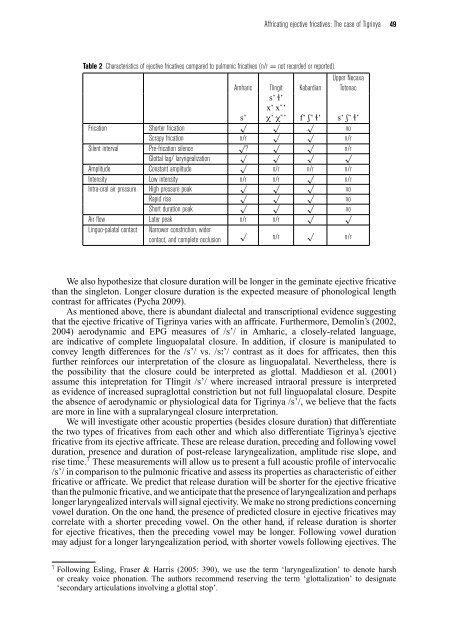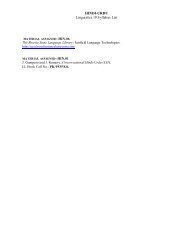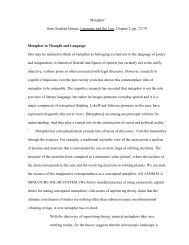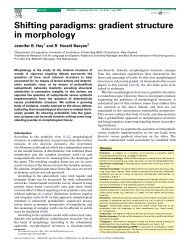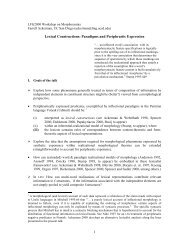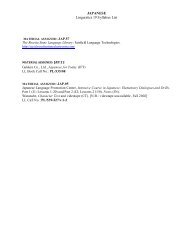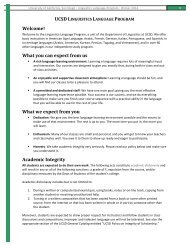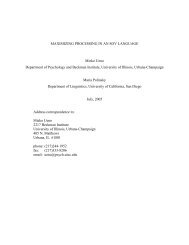48 Ryan K. Shosted & Sharon Roseor glottalization to words ending in sonorants and <strong>fricatives</strong> (there are no word-final stops oraffricates). Yet, there is considerable variation in how these derived glottalized <strong>fricatives</strong> arerealized, as well as underived glottalized obstruents: stop, fricative and affricate productionsare attested with various forms <strong>of</strong> glottalization. Maddieson et al. (2009) report descriptiveacoustics and did not take any aerodynamic measurements. For velars, a stop [k’] is themost common production, whereas coronal obstruents are typically realized as affricate[ts’ t¬’]. Affricate <strong>ejective</strong>s are characterized by silent closure followed by frication, a releaseburst and a period <strong>of</strong> (nearly) silent glottal closure. Fricative realizations can involve pre- orpost-glottalization, described as glottal constriction sequenced with frication (e.g. [s/] and[/s]); these tokens lack the glottal closure and release burst characteristic <strong>of</strong> <strong>ejective</strong>s. <strong>The</strong>pronunciation [f/] is the most common realization for the labial, although affricate [pf’] isalso attested. From 630 tokens from eight speakers, only two tokens exhibited an <strong>ejective</strong>fricative realization: [¬’]. <strong>The</strong>refore, it appears that Oaxaca Chontal does not have <strong>ejective</strong><strong>fricatives</strong> per se, only <strong>ejective</strong> affricates, or glottal–fricative sequences, as in Yapese. <strong>The</strong> datafrom Oaxaca Chontal therefore lend credence to the hypothesis that <strong>ejective</strong> <strong>fricatives</strong> presentaeroacoustic challenges, and one means <strong>of</strong> solving this problem is by realizing the <strong>ejective</strong>fricative via affrication.1.3.7 SummaryIn conclusion, <strong>ejective</strong> <strong>fricatives</strong> are characterized by shorter frication duration than pulmonic<strong>fricatives</strong> (except for Upper Necaxa Totonac), with a following (near-)silent lag before vowelonset, presumably associated with the time that it takes for the larynx to drop and regular vocalfold vibration to initiate under an egressive pulmonic airflow regime. <strong>The</strong> frication itself is<strong>of</strong>ten described as ‘scrapy’ or ‘pulsing’, perhaps indicative <strong>of</strong> an oral constriction that opensand closes quickly. Ejective <strong>fricatives</strong> generally show higher intraoral pressure peaks, typicallyoccurring earlier than they do during pulmonics. High supralaryngeal cavity pressure is <strong>of</strong>course a hallmark <strong>of</strong> <strong>ejective</strong>s. <strong>The</strong> timing <strong>of</strong> the peak suggests that pressure builds more slowlyin pulmonic <strong>fricatives</strong>, a difference that is likely to have acoustic consequences as well. UpperNecaxa Totonac is an exception to this intraoral pressure pattern. Palatograms reveal widercontact and narrower constriction, and in some <strong>case</strong>s evidence <strong>of</strong> total alveolar or alveopalatalocclusion, particularly in Amharic. Silence preceding frication is sporadically reported andwas interpreted as glottal closure (without further comment) for Tlingit (Maddieson et al.2001). This can be seen on the right-hand side <strong>of</strong> Figure 2. A summary <strong>of</strong> these characteristicsfor four languages, excluding Yapese and Lowland Oaxaca Chontal (because their so-called<strong>ejective</strong> <strong>fricatives</strong> have been interpreted as a sequence <strong>of</strong> fricative plus glottal stop), is shownin Table 2. None <strong>of</strong> the languages surveyed had geminate <strong>ejective</strong> <strong>fricatives</strong>.1.4 <strong>The</strong> problem<strong>The</strong> motivation for our study is based on several observations: (i) most languages that have<strong>ejective</strong> <strong>fricatives</strong> also have <strong>ejective</strong> affricates (see Figure 1); (ii) <strong>Tigrinya</strong> <strong>ejective</strong> <strong>fricatives</strong>do not contrast with homorganic affricates, but the <strong>fricatives</strong> are occasionally transcribed ordescribed as affricates and dialectal variation along these lines is reported; (iii) linguopalatalocclusion has been reported for the <strong>ejective</strong> fricative <strong>of</strong> Amharic, a related language; and (iv)the buildup <strong>of</strong> intraoral pressure during <strong>ejective</strong> consonants can be achieved most effectivelyby creating a complete supralaryngeal occlusion while raising the larynx. Thus, our study willinvestigate the AFFRICATION HYPOTHESIS, i.e. there is a complete supralaryngeal occlusionbefore the onset <strong>of</strong> frication in <strong>Tigrinya</strong> <strong>ejective</strong> <strong>fricatives</strong>. If this hypothesis is correct, weexpect that <strong>ejective</strong> fricative /s’/ will manifest a silent interval preceding fricative release andthat pulmonic fricative /s/ will not. We will report measures <strong>of</strong> this pre-release silent intervalas ‘closure duration’ throughout the paper.
<strong>Affricating</strong> <strong>ejective</strong> <strong>fricatives</strong>: <strong>The</strong> <strong>case</strong> <strong>of</strong> <strong>Tigrinya</strong> 49Table 2 Characteristics <strong>of</strong> <strong>ejective</strong> <strong>fricatives</strong> compared to pulmonic <strong>fricatives</strong> (n/r = not recorded or reported).Upper NecaxaAmharic Tlingit Kabardian Totonacs’ ¬’x’ x ’s’ X’ X ’ f’ S’ ¬’ s’ S’ ¬’√ √ √FricationShorter fricationno√ √Scrapy fricationn/rn/r√ √ √Silent interval Pre-frication silence? n/r√ √ √ √Glottal lag/ laryngealization√AmplitudeConstant amplituden/r n/r n/r√Intensity Low intensity n/r√n/r√ √n/rIntra-oral air pressure High pressure peakno√ √ √Rapid riseno√ √ √Short duration peakno√ √Air flow Later peak n/r n/rLinguo-palatal contact Narrower constriction, widercontact, and complete occlusion√n/r√n/rWe also hypothesize that closure duration will be longer in the geminate <strong>ejective</strong> fricativethan the singleton. Longer closure duration is the expected measure <strong>of</strong> phonological lengthcontrast for affricates (Pycha 2009).As mentioned above, there is abundant dialectal and transcriptional evidence suggestingthat the <strong>ejective</strong> fricative <strong>of</strong> <strong>Tigrinya</strong> varies with an affricate. Furthermore, Demolin’s (2002,2004) aerodynamic and EPG measures <strong>of</strong> /s’/ in Amharic, a closely-related language,are indicative <strong>of</strong> complete linguopalatal closure. In addition, if closure is manipulated toconvey length differences for the /s’/ vs. /s˘’/ contrast as it does for affricates, then thisfurther reinforces our interpretation <strong>of</strong> the closure as linguopalatal. Nevertheless, there isthe possibility that the closure could be interpreted as glottal. Maddieson et al. (2001)assume this intepretation for Tlingit /s’/ where increased intraoral pressure is interpretedas evidence <strong>of</strong> increased supraglottal constriction but not full linguopalatal closure. Despitethe absence <strong>of</strong> aerodynamic or physiological data for <strong>Tigrinya</strong> /s’/, we believe that the factsare more in line with a supralaryngeal closure interpretation.We will investigate other acoustic properties (besides closure duration) that differentiatethe two types <strong>of</strong> <strong>fricatives</strong> from each other and which also differentiate <strong>Tigrinya</strong>’s <strong>ejective</strong>fricative from its <strong>ejective</strong> affricate. <strong>The</strong>se are release duration, preceding and following vowelduration, presence and duration <strong>of</strong> post-release laryngealization, amplitude rise slope, andrise time. 7 <strong>The</strong>se measurements will allow us to present a full acoustic pr<strong>of</strong>ile <strong>of</strong> intervocalic/s’/ in comparison to the pulmonic fricative and assess its properties as characteristic <strong>of</strong> eitherfricative or affricate. We predict that release duration will be shorter for the <strong>ejective</strong> fricativethan the pulmonic fricative, and we anticipate that the presence <strong>of</strong> laryngealization and perhapslonger laryngealized intervals will signal ejectivity. We make no strong predictions concerningvowel duration. On the one hand, the presence <strong>of</strong> predicted closure in <strong>ejective</strong> <strong>fricatives</strong> maycorrelate with a shorter preceding vowel. On the other hand, if release duration is shorterfor <strong>ejective</strong> <strong>fricatives</strong>, then the preceding vowel may be longer. Following vowel durationmay adjust for a longer laryngealization period, with shorter vowels following <strong>ejective</strong>s. <strong>The</strong>7 Following Esling, Fraser & Harris (2005: 390), we use the term ‘laryngealization’ to denote harshor creaky voice phonation. <strong>The</strong> authors recommend reserving the term ‘glottalization’ to designate‘secondary articulations involving a glottal stop’.


